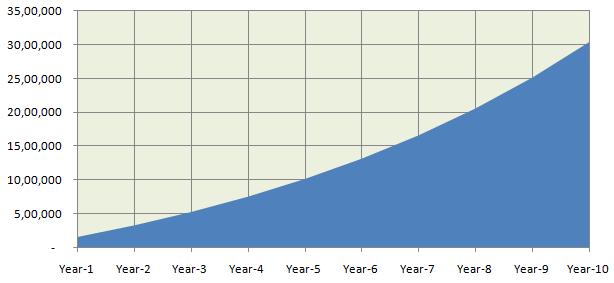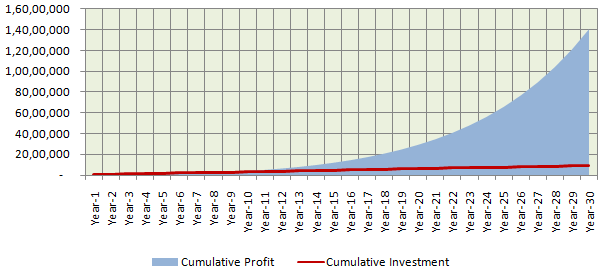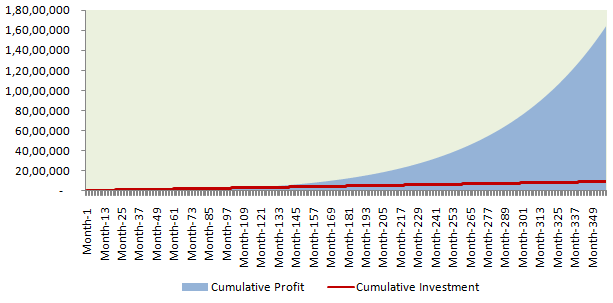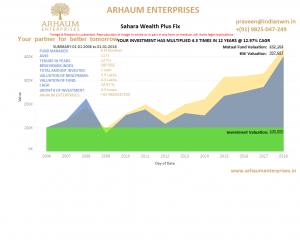As an investor, I like to keep myself abreast with latest developments in the market by regularly visiting stock market and mutual fund related websites. Also, my interest in what investors are thinking, takes me to discussion threads on a few online discussion boards. A lot of the content on these portals, especially stock market related portals and discussion boards are centered on specific stocks. The mutual fund portals often have content on broader investment principles, but based on the comments and queries received by Advisorkhoj, I get a sense that investors are looking to invest in the best mutual funds.
While multi-bagger stocks have created wealth for investors, these stocks are very difficult to identify by average retail investors, more so at the right price – the endeavor to create wealth by investing heavily in stocks that you expect to multiply 10 – 15 times can be risky. The secret to wealth creation is actually much simpler, the power of compounding.
What is power of compounding?
Power of compounding is essentially making your money work for you. Think about a daily wage laborer – if he works for 300 days, he will get more money than if he works for 100 days. Your money, if invested wisely over a long investment horizon, is like a daily wage laborer; every extra day your money works, will get you incremental money. Let us now understand it from a theoretical perspective.
Money when invested earns returns – how much returns it earns, depends on the asset class and asset type. Historical data shows us that, equity is the best performing asset class in the long term. Returns earned by your investments get added to your investments and the overall amount earns higher returns.
Let us assume you invested Rs 10 lakh @ 15% returns. After 1 year, you will make a profit of Rs 1.5 lakhs. This profit, unless it is withdrawn, will get added to your investment and your investment amount will be Rs 11.5 lakhs. In the second year, at the same rate of return, you will make a profit of Rs 1.72 lakhs, more than what you made in year one. This profit of Rs 1.72 lakhs will get added to your investment and your investment amount at the end of year two will be Rs 13.2 lakhs. In the third year, at the same rate of return, you will make a profit of Rs 1.98 lakhs. The chart below shows the cumulative profit growth every year.

You can see that the profit growth is not linear but exponential. By year 5, the cumulative profit is more than your investment amount. By year 8, the cumulative profit is more than double your investment amount and by year 10, the cumulative profit is more than three times your investment amount.
SIP and the power compounding
Power of compounding is not as much about what you buy and how much you buy, as it is about how you buy and how you manage. Sounds confusing? Let us illustrate with the help of an example.
Let us assume that you invest Rs 10 lakhs in lump sum in a mutual fund, which will give 20% CAGR returns, for 10 years. 20% CAGR over 10 years, is a pretty aggressive assumption, but for the sake of the argument, let us assume you were lucky enough to invest in such a fund. What will be your investment value after 10 years? Rs 62 lakhs, more than 6 times returns in 10 years, which is quite impressive.
Let us now assume, you invest Rs 30,000 every year over the next 30 years – in total, you invest Rs 9 lakhs. Let us further assume that you get a CAGR return of 15% over 30 years. What will be your investment value after 30 years? Rs 1.5 Crores, nearly 2.5 times what you got by investing in lump-sum, that too by investing Rs 1 lakh less and at lower annualized returns. The chart below shows the cumulative profit growth for annual investments.

Investing is not just about money, it is more about time. This is the essence of power of compounding. The power of compounding is more magnified in SIP, because you can start with a smaller amount, invest regularly and remain invested longer.
Let us take this example further. You got Rs 1.5 Crores by investing Rs 9 lakh over 30 years (Rs 30,000 per annum) versus Rs 62 lakhs by investing Rs 10 lakhs in lump sum over 10 years. Let us now assume that, instead of investing Rs 30,000 on an annual basis, you spread the same annual amount over 12 months, in other words, you invest Rs 2,500 per month over the next 30 years. The tenor of investment remains the exactly the same to what it was when you were investing annually, but what will be your investment value after 30 years? Rs 1.75 Crores, which is Rs 25 lakhs more than what you got from the same investment capital, over the same tenor!
You got the extra returns because you were investing monthly instead investing annually – this again is a demonstration of the awesome power of compounding. By investing on a monthly basis you made your money work harder (instead of being idle throughout the year).The chart below shows the cumulative profit growth for annual investments.

Rupee Cost Averaging
Apart from the power of compounding, SIPs enjoy another major advantage, especially in equity mutual funds. Equity as an asset class is intrinsically volatile – prices move up and down on a daily basis. You may like to read here why mutual funds are the best investment class?
By investing through mutual fund monthly SIPs, you will be able to take advantage of volatility by investing at various price levels. This is known as Rupee Cost Averaging. Over long investment tenors, asset prices will follow a secular trend (unaffected by short term volatility). Therefore, rupee cost averaging of purchase price can help you get enhanced returns in the long term.
Would you not like to know why continue with SIPs even in higher markets
Conclusion
Power of compounding is simple to understand, but we often do not realize its potential. In this blog post, we discussed the importance of power of compounding in wealth creation. Once you get a sense of the potential of compounding, you will realize that you can have considerable control over your financial destiny – more than what you would have imagined earlier.
Mutual SIP is a convenient, hassle free way of exploiting the power of compounding from your regular monthly savings – in fact, once initiated your financial plan can run on auto-pilot with SIPs. All that is required on your part is patience and discipline.
In case you are looking for superior investment planning with mutual fund SIPs, do read this.



